Business process automation (BPA) is a foundational technology trend for the modern enterprise and startups in 2025. By leveraging software and AI to handle repetitive, rule-based tasks, companies are becoming more resilient and competitive.
But just how big is the business process automation market? And how quickly are businesses adopting it?
In this article, we’ll take a closer look at key business process automation statistics, along with adoption rates, challenges, ROI, and future growth projections.
Before moving into the full list, here are the top business process automation statistics for 2025:
Ready to explore the complete list? Let’s get started!
The digital process automation market is growing significantly, fueled by global investments in AI and workflow optimization. From core BPA to intelligent automation, all segments are on a strong upward path. Let’s take a further look.
The global BPA market is valued at $15 billion and will double by the end of the decade
As of 2024, the global business process automation (BPA) market was valued between $14.87 billion and $15.81 billion. Driven by the enterprise-wide push for digital transformation, the market will expand, with some forecasts predicting it will hit $32.59 billion in 2031.
Here is a look at several market forecasts:
2024-2025
The market is expected to grow from $14.87 billion to $16.32 billion.
9.8%
2024-2029
The market is projected to hit $28.95 billion.
15.4%
2024-2029
The market is forecast to expand by $17.68 billion.
18.4%
2024-2031
The market will rise from $15.81 billion to $32.59 billion.
10.9%
The intelligent automation market is expected to triple by 2030
The Intelligent Process Automation (IPA) market, which combines BPA with AI, was estimated at $14.55 billion in 2024. It’s projected to surge to $44.74 billion by 2030, growing at a robust 22.6% CAGR from 2025 to 2030.
The market reflects surging demand for “hyperautomation” technologies that integrate AI, RPA, and advanced analytics. In fact, Gartner predicts that worldwide spending on this hyperautomation will approach $600 billion in the mid-2020s.
The hyperautomation market itself reached $56.1 billion in 2024 and grew to $65.7 billion in 2025 (~17% year-over-year), with forecasts of $144.22 billion by 2030.
As a part of the IPA market, robotic process automation statistics on growth show the highest CAGR of 43.9%. The RPA market size was valued at $3.79 billion in 2024 and is expected to increase tenfold ($30.85 billion by 2030).
North America holds the largest share of the automation market, yet Asia-Pacific is the fastest-growing region
North America accounted for about 38% of global intelligent automation revenue in 2024. Also, it comprised 36% of hyperautomation spend, the top region by revenue.
However, the Asia-Pacific is the fastest-growing region for BPA adoption. In the broader automation arena, Asia-Pacific leads industrial automation with ~39% of 2024 revenue, driven by heavy investments in China and South Korea.
Sources: Business Research, Grand View Research, Precedence Research, Gartner
The adoption of automation in companies is no longer limited to early adopters. A majority of businesses are now actively investing in BPA solutions to improve quality and gain a competitive edge.
2 in 3 businesses have already started investing in automation
As of 2024, approximately 60% of businesses have implemented some form of process automation solution to handle tasks previously completed by employees.
Of these, 38% are piloting (1-10 automations), 12% are implementing (11-50 automations), and 8% are automating at scale (51+ automations). The number of organizations deploying at scale has doubled compared to the 2018 findings.
The main goal of using software, equipment, or automation technology is to:
Among those who have automated some sort of processes, 37% of all (and 55% of large companies) already use AI.
The COVID-19 pandemic was a significant catalyst for BPA adoption
According to McKinsey’s business process automation statistics, over 85% of organizations accelerated their digitalization due to the COVID-19 pandemic’s push toward remote work. Of them, 67% accelerated automation and artificial intelligence. Specifically, they adopted robotics, autonomous vehicles, and AI-driven software.
3 in 4 leaders see automation as a critical competitive advantage
Roughly 75% of executives state that implementing automation gives their company a significant competitive edge.
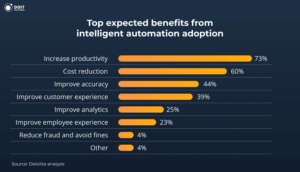
According to Gartner, 80% of executives believe they can apply automation to any business decision, not just back-office tasks. This sentiment is echoed by the C-suite’s growing embrace of automation in strategic planning and decision-making processes.
In fact, about 50% of corporate strategists estimate that half of all strategic planning activities could be automated, whereas only ~15% are automated today.
Sources: Duke University, Deloitte, McKinsey, Gartner
Despite high adoption rates, implementing automation is not without its difficulties. Businesses cite complex workflows, legacy technology, process fragmentation, and biases as significant barriers. Let’s take a look.
78% of businesses believe that complex workflows complicate automation
In 2025, an average organizational workflow includes over 50 components, 19% more than in 2020. Most common components include:
To combine all components, 83% of organizations consider tools to orchestrate tasks across diverse endpoints. Yet, 85% of respondents believe that combining several automated tasks complicates overall process management.
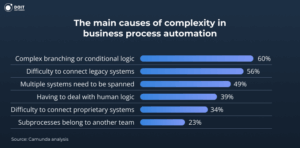
82% of organizations say their process automation is starting to become outdated
Almost 3 in 4 businesses say that their automation cannot keep pace with the rate of change in modern organizations. However, it doesn’t make them cut costs; 83% plan to increase their investment in automation by 10% or more.
36% of businesses identify process fragmentation as the biggest barrier to intelligent automation adoption
Process fragmentation refers to the diversity and inconsistency in how daily tasks and workflows are handled across teams or desktops. Also, 17% of companies see IT readiness (infrastructure, systems) as a challenge, while those piloting automation complain about the lack of vision to deploy it.
78% of organizations are concerned that employees see AI as a “black box”
78% of executives express concern about user trust in AI, thinking of it as a “black box”. Almost as many (77%) expect AI/automation to challenge current operational structures, possibly triggering role changes or ethical dilemmas.
Get inspired by our article “n8n vs Make vs Zapier: Which is Best for Workflow Automation?”
Nearly all business departments apply automation in some form, but some functions are leading the way. Here are some key workflow automation statistics broken down by department.
1 in 4 dollars spent on hyperautomation comes from the financial industry
Banking, Financial Services & Insurance (BFSI) is a major driver of automation spending. In the hyperautomation domain, BFSI alone accounted for roughly 28% of total market share in 2024 (the largest of any industry). Nearly 88% of finance and insurance executives report that they have accelerated automation implementation since 2020.
8 out of 10 financial tasks are ripe for automation
Experts estimate up to 80% of financial transactional workflows (e.g., invoicing, reconciliations) could be automated with current technology. Many firms are heading that way, and automation in finance is yielding tangible results. For example, 93% of CFOs reported faster invoice processing thanks to digital automation.
Furthermore, 83% of CFOs said that accounts payable workflow automation reduced friction by better integration of payments. However, among those still experiencing delays, 80% blame the lack of AI-based automation for the bottlenecks.
Automation frees up over 500 hours annually in finance departments
The financial automation market itself is growing rapidly (projected >14% CAGR to $20.7B by 2032). Use cases like payment automation can save hundreds of hours. Businesses that implemented automated payment processing freed up over 500 hours per year in finance departments (equivalent to about 9.9 hours per week).
Sources: Forbes, Pymnts, GMI, American Express, McKinsey
75% of businesses use at least one form of marketing automation
In 2024, 58% of marketing decision-makers automated email campaigns, 49% automated social media posting, and 33% automated content management.
Other popular areas of automation include paid ads (32%), SMS marketing (30%), campaign tracking (28%), and landing pages (27%).
61% of businesses that automate marketing do so to increase lead generation
Among other popular reasons are sales revenue growth (47%), improving customer engagement (36%), marketing productivity (29%), and improving campaign measurability (28%).
76% of companies that use marketing automation earn ROI in their first year
Out of them, 12% earn the return on investment within 1 month, and 32% in 6 months.
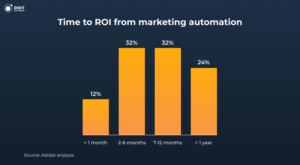
Marketing automation helps 80% of companies earn more leads than they can without it. 77% of marketers also report increased conversions.
By 2028, 9 in 10 enterprise software developers will use AI code assistants
According to Gartner’s business process automation statistics forecasts, 90% of software engineers working in enterprise organizations will use AI to automate programming, compared to 14% in 2024. The role of the developer will shift from implementation to orchestrating tools or even a prompt engineering job.
Also, Anthropic states that 79% of conversations on their Claude Code are already dedicated to automation. Developers use it to build software architecture and code design, create UI/UX components, and automate debugging.
AI and automation in IT operations save an average of 55 minutes per incident
Organizations adopting AI features and automated workflows in their IT operations benefit from significant time savings when resolving incidents. AI-driven capabilities like automated issue summarization let IT staff resolve incidents 55 minutes faster on average than before.
Moreover, AI-powered virtual agents handle repetitive queries and deflect up to 30% of requests to self-service solutions. It saves over 25 minutes per service request for end users.
HR automation usage has skyrocketed by nearly 600%
HR departments are rapidly adopting automation and AI to handle repetitive admin work. In recent years, HR automation usage surged by 599%, with HR chatbots now accounting for 39% of employee-facing automations. Despite this growth, HR professionals still devote 57% of their week to administrative tasks like forms and payroll, indicating substantial room for further automation.
1 in 4 companies have automated their HR processes
According to the SHRM report, 26% of companies use AI and automation to support their hiring processes. Nearly 2 in 3 organizations only began automating HR processes within the past years.
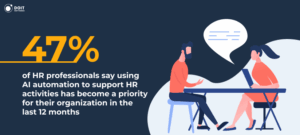
64% of HR specialists who use AI automation utilize it for recruiting and interviewing
Also, 43% use AI for learning and development, 25% for performance management, and 10% for productivity monitoring.
In the context of interviewing and hiring, recruiters most often use AI/automation to:
Other use cases include interview scheduling (22%), finding prospective sources of candidates (19%), and identification of potential discriminatory, biased, or non-inclusive language within their job descriptions (18%).
Sources: SHRM
What are the tangible advantages of automation in business? Read on to learn how many companies succeed in achieving a return on investment in process automation.
Intelligent automation can yield 22% average cost reductions and 11% revenue increase over 3 years
Deloitte’s survey shows that organizations using “intelligent automation” (RPA + AI) expect major financial benefits. On average, respondents projected 22% cost savings and 11% revenue growth over 3 years. Those already scaling automation report having achieved a 27% reduction in costs so far.
Also, 36.6% of enterprises that implemented automation say it reduced costs by over 25%, while 12.7% reported more than 50% cost savings.
3 out of 4 organizations report that automation has increased productivity for knowledge workers
Per KPMG’s business process automation statistics, 74% of organizations say AI/automation has already boosted the productivity of their knowledge workers. In the same survey, 80%+ expect automation shifts will push knowledge workers toward more creative and strategic roles.
Only 1 in 3 organizations has scaled AI to production, achieving ROI on multiple use cases
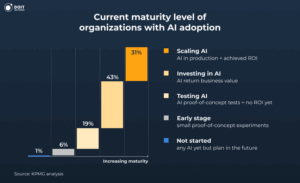
While many organizations are experimenting, true scaling is still rare. Around 31% are in the “scaling AI” stage, where they were able to achieve ROI. 43% are investing in use cases that provide some business value, 19% are testing without any ROI yet, and 6% are in the early stages.
Contrary to common fears of job replacement, data suggests automation will be a net creator of jobs. However, it will require a massive shift in worker skills and a focus on training and development. Let’s take a look at the impact of business process automation on the workforce.
Automation will displace some jobs while creating 1.8x more others
By 2030, automation & AI are projected to displace 92 million jobs but also create 170 million new roles, for a net gain of 78 million jobs globally.
40% of employers already expect to reduce the workforce where AI can automate tasks. Forecasts say clerical and secretarial workers should expect the most significant decline in jobs.
In turn, frontline jobs like farmworkers and delivery drivers will see the largest increase in absolute terms of volume. Technology-related jobs will be the fastest-growing group in percentage terms, including data engineers, AI and machine learning developers, and software developers.
39% of workers’ core skills are expected to change by 2030
According to the World Economic Forum’s Future of Jobs Report 2025, almost 4 in 10 core skills will undergo major shifts due to the rise of AI and automation.
By 2030, 59% of workers will need training:
Employers cite skills gaps (63%) as the biggest barrier to transformation and say they will respond by prioritizing upskilling (85%). Also, 70% will hire staff with new skills, 40% will reduce staff in obsolete roles, and 50% will transition employees into growth areas.
The most in-demand soft skills will be analytical thinking, resilience, technological literacy, and leadership. In turn, the fastest-growing ones will be AI skills, knowledge of big data tools (87% net increase), followed by cybersecurity proficiency (70% net increase).
Automation is improving job satisfaction for 9 in 10 employees
Far from being a threat, automation is seen as a tool that enhances the work experience. Around 89% of full-time workers say automation has improved their job satisfaction. And 91% believe that automation tools save them time and provide a better work-life balance.
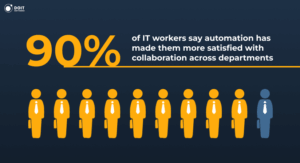
The departments most satisfied with their automated jobs are IT (93%), operations (90%), and customer service (88%). In automation tasks, the greatest satisfaction is derived from data reporting, planning, and analysis (90%).
Initial employee skepticism about automation tends to fade after implementation
Once workers realize automation is a support tool (not a threat), they become strong proponents. 81% of automation users now don’t worry that it will replace their job. Additionally, 88% of employees trust the accuracy of automated systems to complete tasks without errors.
Sources: World Economic Forum, Salesforce
Finally, let’s take a look at business process automation statistics for the years to come.
80% of organizational workflows will be automated by 2029
The role of artificial intelligence in BPA will only grow. In 2025, 93% of businesses already have a center of excellence for process automation, but only 46% of processes are automated. Forecasts predict that this figure will almost double within 4 years.
By 2030, 34% of all work will be done by machines
We are likely to see routine decision-making handled by AI copilots, with humans focusing on exceptions and strategy. By 2030, employers forecast that about 1 in 3 tasks will be fully done by machines (vs 22% in 2025), with an additional 33% involving a machine-human combination.
Automation and AI will boost GDP by up to 26.1% for local economies by 2030
PwC’s business process automation statistics estimate that by 2030, 45% of total global economic gains will be driven by product enhancements and efficiencies from AI and automation technologies.
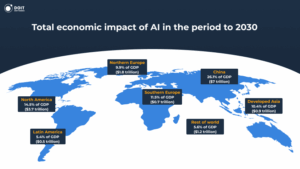
In dollar terms, forecasts project that automation and generative AI could add $15.7 trillion to the global economy. The greatest boost will be in China (26.1% of GDP) and North America (14.5%).
Automation is expected to increase workforce capacity by 27%
In the next three years, organizations expect that process automation will expand what their workforce can achieve by 27%, equivalent to 2.4 million full-time employees.
Sources: IDC, World Economic Forum, PwC, Deloitte
That’s a wrap-up of the latest business process automation statistics. Overall, in 2025, automation has moved from experimental technology to a business necessity. The market will double by 2030, with 60% of companies already investing in automation solutions.
Executives expect tangible outcomes. With intelligent automation, many plan for 22% cost reductions and 11% revenue growth over three years. However, success isn’t automatic. 78% of businesses struggle with complex workflows, and only 31% have scaled to production.
If you want to take a step towards automation ROI, bring in experts who understand RPA platforms, AI integration, workflow orchestration, and your specific business systems. Request CVs from DOIT Software to hire experienced automation developers who can help you in this journey!
Get a consultation and start building your dream team ASAP.
Request CVsBusiness process automation involves using technology, software, and AI to handle repetitive, rule-based tasks that humans previously did manually.
The primary benefits reported by companies include increased product quality (58%), higher output (49%), and reduced labor costs (47%). Additionally, organizations using intelligent automation project an average 22% cost reduction and 11% revenue growth over three years.
While automation will displace certain repetitive roles, it is projected to be a net creator of jobs. The World Economic Forum predicts that by 2030, automation will create 170 million new roles while displacing 92 million, resulting in a net gain of 78 million jobs globally. These automation facts suggest a significant focus on upskilling and reskilling the future workforce.










